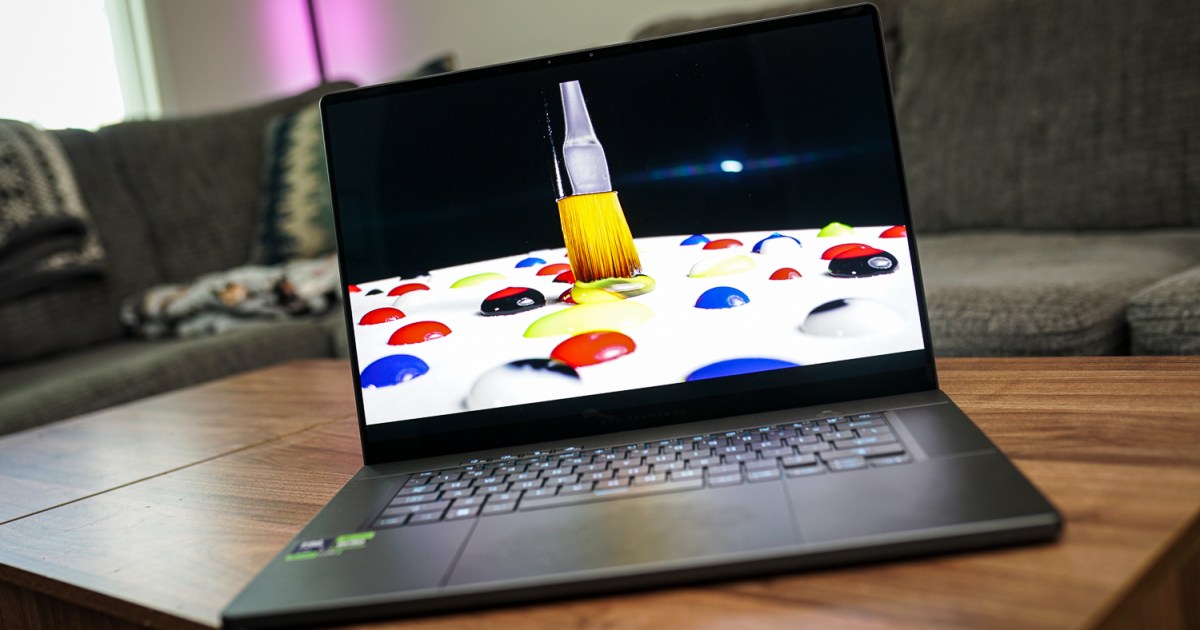Asus ROG Zephyrus G16
MSRP $2,000.00
“The Asus ROG Zephyrus G16 will challenge your expectations about what defines a gaming laptop.”
Pros
- Beautiful OLED screen
- Thinner and lighter than a MacBook Pro
- Design is gorgeous
- Solid battery life
- Comfortable keyboard and huge trackpad
Cons
- Some performance compromises
- Gets loud under load
The Asus ROG Zephyrus G16 confuses me. On the surface, it should be one of the best gaming laptops you can buy. It’s thinner and lighter than a MacBook, even when packing an RTX 4090 under the hood, and it has what might be the best display you can find on a laptop. Combine that with a reasonable price, a fantastic keyboard, and surprisingly good battery life, and the Zephyrus G16 should be a slam dunk.

Get your weekly teardown of the tech behind PC gaming
This is a laptop that challenges expectations, though. It straddles the line between a creator and gaming laptop, making compromises along the way that a machine like the Lenovo Legion 9i doesn’t run into. This is a still a great laptop that has a lot to offer gamers on the go, but there’s a little more to the story than what you see on the surface.
Asus ROG Zephyrus G16 (2024) specs

Unlike the 2024 Zephyrus G14, you have a wide range of configuration options with the 16-inch model. Asus limits the processor options to Intel’s Core Ultra 7 155H or Core Ultra 9 185H, but you can pair the CPU with a graphics card from an RTX 4050 all the way up to an RTX 4090.
I reviewed an RTX 4070 configuration — you can see the exact configuration I tested below — and it feels like the sweet spot for this portable laptop. My college Kunal Khullar has been testing the RTX 4090 configuration, and he’s mentioned how it’s prone to overheating. That isn’t surprising, either, considering the Zephyrus M16 from last year showed similar issues with the RTX 4090.
| Asus ROG Zephyrus G16 (2024) | |
| Dimensions | 13.94 x 9.69 x 0.64 inches |
| Weight | 4.08 pounds |
| Processor | Intel Core Ultra 9 185H (16 cores, 22 threads, up to 5.1GHz) |
| Graphics | Nvidia RTX 4070 (105W TGP) |
| RAM | 32GB LPDDR5X-7467 (soldered) |
| Display | 2.5K OLED, 240Hz |
| Storage | 1TB PCIe 4.0 NVMe SSD |
| Touch | N/A |
| Ports | 2x USB 3.2 Gen 2 Type-A, 1x USB 3.2 Gen 2 Type-C, 1x Thunderbolt 4, 1x SD card reader, 1x 3.5mm headphone, 1x HDMI 2.1 |
| Wireless | Wi-Fi 6E, Bluetooth 5.3 |
| Webcam | 1080p with Windows Hello |
| Operating system | Windows 11 Pro |
| Battery | 90 WHrs |
| Price | $2,000 |
| Where to buy |
You can scale up to an RTX 4090, but you probably shouldn’t. A lot of that comes down to the Total Graphics Power, or TGP, of the Nvidia GPUs available for the Zephyrus G16. Asus restricts the power to the graphics card to avoid heat and noise issues that could pop up in such a thin laptop. You’re not getting the full performance out of the GPU, which is a more fair compromise with a card like the RTX 4070 than the RTX 4090.
Outside of the graphics card, Asus also compromises with the RAM. It’s soldered, so you can’t upgrade it down the line. Presumably, this is a consequence of the thinness of the laptop, but regardless, it’s something you should keep in mind. If you plan on picking up the Zephyrus G16, I wouldn’t recommend getting anything less than 32GB of memory.
A whole new look
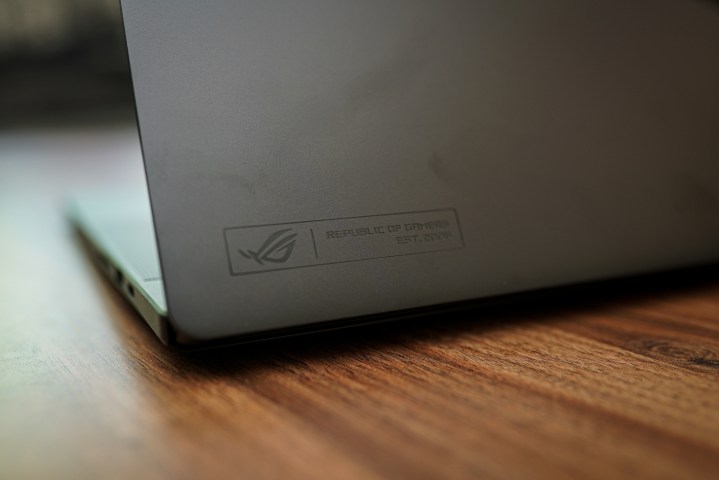
That’s insanely light given how much power is under the hood. And if it’s lighter than a MacBook Pro, you can bet it’s lighter than the competing Windows options. For reference, the Razer Blade 16 is 5.4 pounds — more than a full pound heavier. It’s such a low weight that I had to pull out my kitchen scale just to check my sanity. Sure enough, the Zephyrus G16 is just 4.08 pounds.
Weight is one thing, but the Zephyrus G16 is also thinner than the MacBook Pro, clocking in at 0.65 inches at its thickest point (the MacBook Pro is 0.66 inches). It’s quite a bit thinner than the Razer Blade 16, too, which comes in at 0.87 inches. Asus has really achieved something special here with the thinness and weight of the Zephyrus G16.

For looks, Asus offers both white and black versions of the Zephyrus G16, but tracking down the white version might not be easy. Most retailers stick with the default black color option, so you may have to order from Asus directly — and usually pay a premium — if you want the white design.
The black looks great, but calling it black doesn’t really nail the color. It’s a very dark gray. The distinction is important here, as previous Zephyrus designs with a plastic body were truly black, and that’s not the case here.
On the lid, you have a stamped ROG logo, which looks fantastic, along with Asus’ new Slash Lighting. It’s a diagonal strip of LED blocks, and although it looks decent, it feels like a step back from the unique AniMe matrix on previous designs. I suspect milling a few hundred tiny holes in aluminum is quite a bit more expensive than doing so in plastic, but still, the Slash Lighting doesn’t feel like a suitable replacement.
Even with the Slash Lighting, the design of the Zephyrus G16 is a massive success. The laptop looks great, but more importantly, it’s thin and remarkably light. It’s one of the only 16-inch laptops I’ve used that feels properly portable, sitting alongside machines like the Alienware x16.
A great port selection
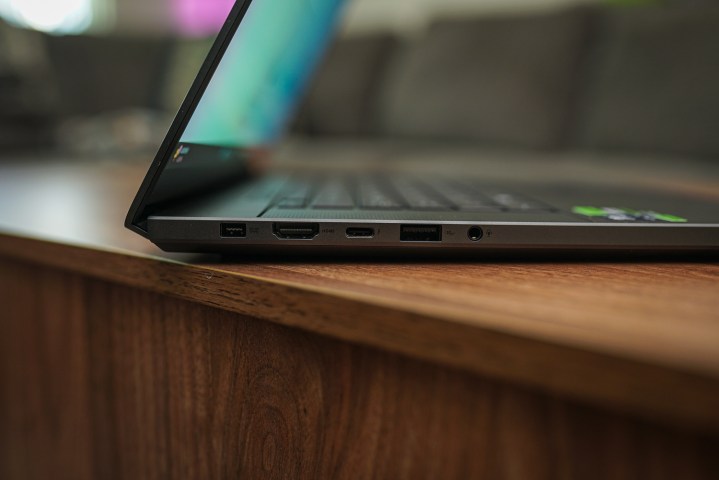
The Zephyrus G16 has a great selection of ports, but the real standout is Asus’ redesigned charging port. It’s a proprietary square connector situated at the back corner of the laptop, and it provides a snug connection for charging without feeling bulky. It’s a huge plus over the direct competition in the Razer Blade 16, which still uses Razer’s chunky right-angle connector for charging.
Elsewhere, you get a pair of USB 3.2 Gen 2 Type-A ports, with one on each side. I much prefer this split over placing them both on one side. You also get a pair of USB-C ports split across the laptop, though the right side uses a USB 3.2 Gen 2 port, while the left uses a Thunderbolt 4 port. Both still support DisplayPort and power delivery.
Along the right side, you also get a full-size SD card reader with support for UHS-II cards, and on the left, there’s a full-size HDMI 2.1 port, along with a 3.5mm headphone jack.
You have everything you need here, like the ability to download pictures from your SD card, connect an extra display, and top off your battery with a portable USB-C charger. You don’t need an external USB hub to effectively use the laptop, and that’s a big plus.
Lovely keyboard, huge trackpad
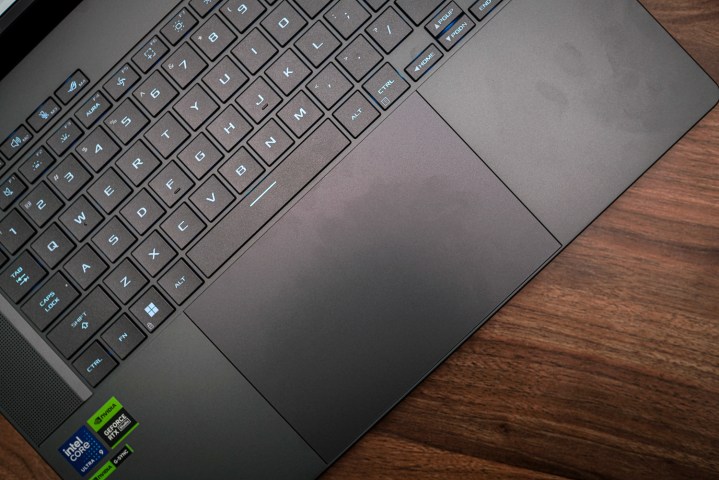
Asus has stayed the course with the keyboard on its Zephyrus laptops for the past several generations, and that’s great. There aren’t any changes with the 2024 Zephyrus G16, as it sports the same long travel and snappy response of previous designs. This is one of the most comfortable keyboards you can get for a gaming laptop, and I even prefer it over that of the Razer Blade 14.
Like previous designs, you also get dedicated volume keys, along with a button for Asus Armoury Crate. It’s a small addition, but Asus leverages the extra space at the top of the key deck to give you easier access to these controls. And, if you don’t like the default setting, you can remap the keys in Armoury Crate.
The trackpad is different. The last-gen Zephyrus M16 had a large enough trackpad, but it now reaches from the front lip of the laptop all the way up to the keyboard. It’s massive, and very comfortable to use when lazily laying your hand on the edge with the laptop in your lap.
A showstopping display

If there’s one big reason to pick up the Zephyrus G16, it’s the screen. It’s an OLED display that tops out at 240Hz, which matches full desktop monitors like the LG UltraGear OLED 27. With a sharp 2,560 x 1,600 resolution, excellent color, and response times as low as 0.2ms, it’s tough saying there’s a better laptop screen on the market. I don’t think there is.
Color is off the charts. In my testing, the display covered 100% of both sRGB and DCI-P3, and an astounding 94% of AdobeRGB. It’s great coverage, and it led to even better color accuracy, with a color error of less than 1 on average.
Brightness isn’t what you get out of a full OLED monitor, but it’s insanely bright with the laptop in front of you. In SDR, the screen topped out at 290 nits for 10% of the screen, which is decent. The same window size in HDR produced just shy of 450 nits, while a 4% window bumped that up to 660 nits. This is great brightness for a laptop.
Fast, but not blistering
One of the most interesting aspects of the Zephyrus G16 is the Core Ultra CPU. We’ve seen this CPU in smaller gaming laptops like the HP Omen Transcend 14, but larger designs generally opt for an AMD chip. Performance holds up, but I’m not seeing a strong argument for going with an Intel chip in this design.
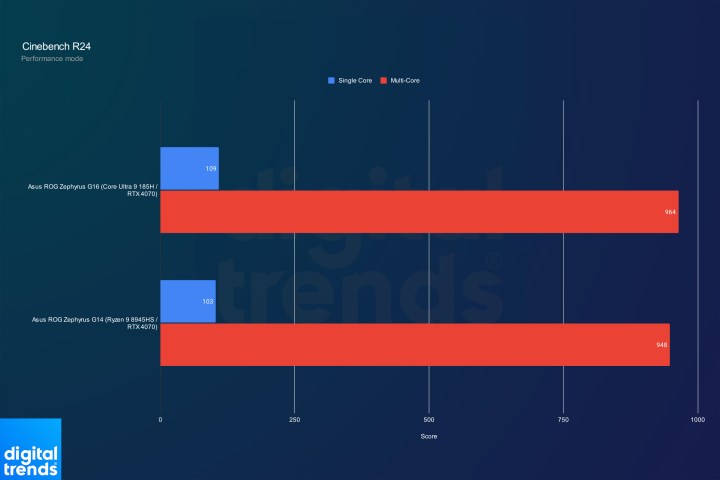
Cinebench R24 provides a good point of comparison. In the default performance mode, the Core Ultra 9 185H provides almost identical multi-core performance to the Ryzen 9 8945HS in the Zephyrus G14. Even with the thin design, the Zephyrus G16 should be able to squeeze more performance out of the CPU simply due to being a larger laptop.
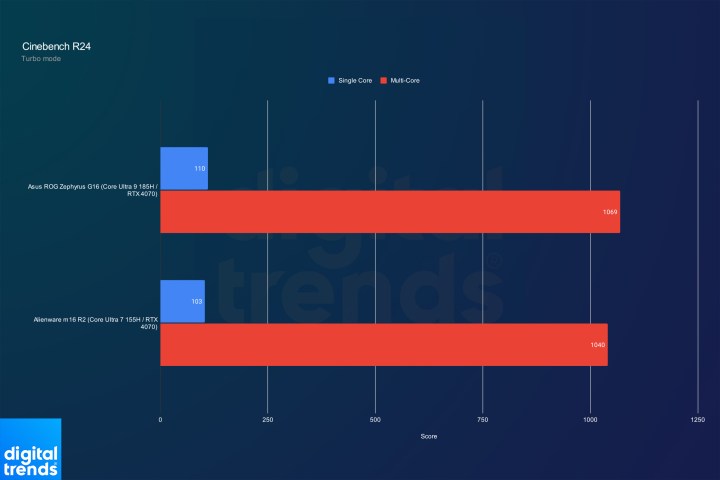
When you jump up to the Turbo mode, the Core Ultra 9 185H posts a higher result, but it’s still almost identical to the Core Ultra 7 155H inside the Alienware m16 R2. The only difference between the Core Ultra 9 185H and Core Ultra 7 155H is a bit of clock speed, and this result tells me the Zephyrus G16 isn’t set up to take advantage of that higher frequency.

Jumping out into a real application, the G16 is a touch behind where I’d expect it to be. In Premiere Pro, the Dell XPS 16 is faster, despite sporting a weaker CPU and downclocked GPU, but the real surprise is the Zephyrus G14. It’s faster, too, suggesting that the AMD CPU may have been a better fit for this 16-inch design. Asus is able to close the performance gap if you run the machine in Turbo mode, though at a big cost in terms of fan noise.
As I’ll cover in the next section as well, the performance of the Zephyrus G16 is acceptable, but it’s certainly not exciting. The specs inside aren’t reaching their full potential, and it’s clear there are compromises in performance to acheive the portable form factor. If you’re after the most performance possible, a thicker — and usually cheaper — 16-inch laptop is a better bet.
Gaming isn’t the top priority

The Zephyrus G16 compromises its gaming performance. This is still a gaming laptop by branding and definition, but it’s a departure from what you’d normally expect out of these parts in a 16-inch machine. Frame rates aren’t much better than what you can find in a similarly configured Razer Blade 14, and sometimes they’re downright worse.
With an RTX 4070 (or higher) at the helm, you can get a good gaming experience out of this laptop with a few tweaks. Those hoping for a MacBook-like gaming laptop that can stand toe-to-toe with a desktop replacement will be disappointed, however.
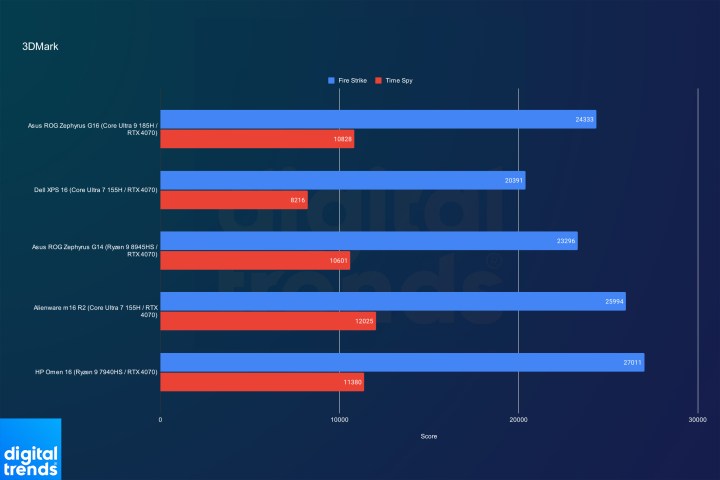
The 3DMark benchmark shows what’s going on here. When jumping from a 14-inch to a 16-inch laptop, you expect a pretty large jump in performance. There’s more room for better cooling. Sure enough, the Zephyrus G16 is faster than the Razer Blade 14 and Zephyrus G14, but the performance gains are marginal. It’s slower than the Alienware m16 R2, despite that laptop sporting a weaker CPU.
In real games, the Zephyrus G14 struggles to maintain 60 frames per second (fps) at its native 1600p resolution with Ultra settings. Less demanding titles like Horizon Zero Dawn are fine, but games that can push your PC like Returnal and Cyberpunk 2077 will need a few tweaks before they can get past 60 fps.
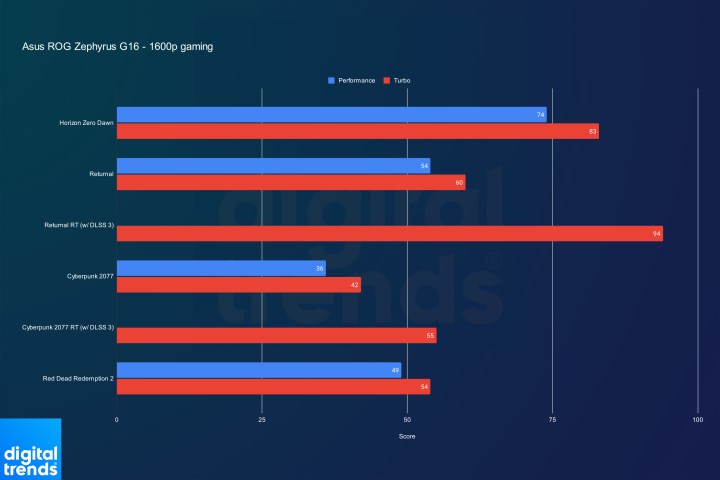
The performance here exposes the big upside of an Nvidia GPU, however. Nvidia’s DLSS 3.5 makes running at higher frame rates trivial, even at Ultra settings and native resolution. The numbers aren’t what I’d expect out of a laptop with the specs of the Zephyrus G16, but you can still get a great gaming experience here.
A lot of that comes down to heat management. The Zephyrus G16 gets loud — not jet engine loud like the MSI GT77 Titan, but loud nonetheless — but it doesn’t get uncomfortably hot. Throw on a pair of cans, turning on upscaling or bump down to the High preset in games, and you’re sitting pretty with the Zephyrus G16.
Still, there’s something to say about expectations here. This is a gaming laptop, but unlike with previous designs, Asus is comfortable compromising performance for a slimmer build and lighter body. For me, it’s a fair trade-off. For others, you can find better performance for less elsewhere, such as with the Lenovo Legion Pro 5.
Surprisingly good battery life
The Zephyrus G16 may sacrifice some performance, but one explanation for its Core Ultra CPU is battery life. In our web-browsing test, it lasted close to eight hours. AMD counterparts like the HP Omen 16 and the Zephyrus G14 lasted just over four hours in this same test. It doesn’t all come down to the CPU, but the Zephyrus G16 has great battery life for a gaming laptop.
Outside of the Core Ultra CPU, the Zephyrus G16 comes with Nvidia Advanced Optimus and a MUX switch, which can be toggled between the discrete and integrated graphics depending on if you’re plugged in or which application you’re running. Thrown in the ability to charge via USB-C, and I wouldn’t have any issue carrying around the Zephyrus G16 all day with a USB-C charger.
Should you buy the Asus ROG Zephyrus G16?
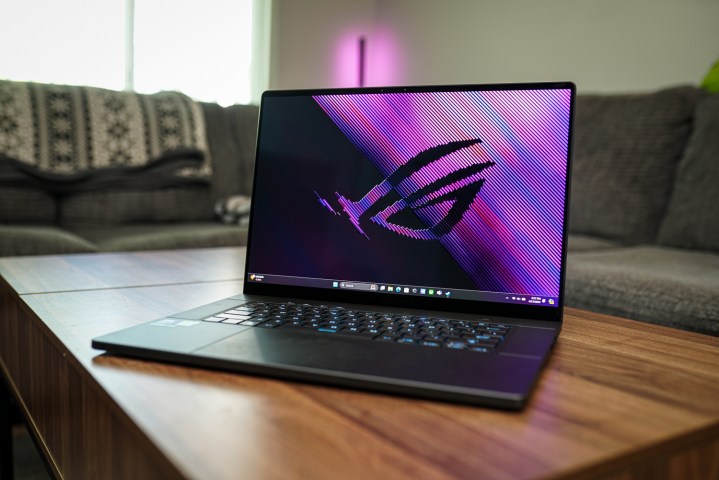
If you’re after raw performance, the Zephyrus G16 isn’t for you. Smaller laptops that are still portable can post higher results, and you may have to make a few compromises in games to get smooth frame rates at native resolution. This is a gaming laptop, but it has an asterisk.
For the way I use a gaming laptop, which is as a portable companion to a desktop, the Zephyrus G16 fills a perfect void. It’s highly portable and just powerful enough to play games without major drawbacks. The price isn’t bad, either, at least considering the specs and build quality on offer here. If you already have a desktop or some other primary platform for playing games, the Zephyrus G16 is a great buy.
As a primary gaming platform, there are better options. The aforementioned Lenovo Legion Pro 5 is thicker, but it’s also cheaper and faster. On the other end, Asus’ own Zephyrus G14 provides similar performance for around the same price, but it’s far more portable.
Editors’ Recommendations

